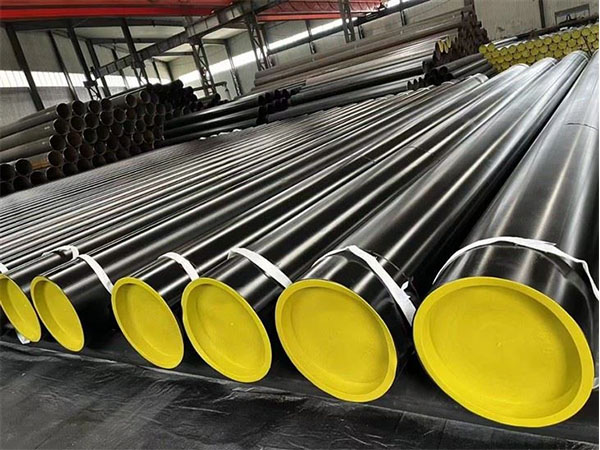Carbon steel welded pipes are pipes made from carbon steel (mainly composed of iron and carbon, with a carbon content typically ranging from 0.06% to 1.5%) through welding processes. Its characteristic is that the weld seams are distributed along the pipe body. According to different Welding methods, it can be classified as
Longitudinal Submerged Arc Welding (LSAW),
Spiral Submerged Arc welding (SSAW) and
Electric Resistance Types such as Welding (ERW).
Compared with seamless pipes, welded pipes have advantages such as low manufacturing cost, precise dimensions, diverse specifications and large production capacity. They are widely used in fields such as oil and gas, water supply and drainage, heat transmission, structural support, agricultural irrigation and scaffolding.
The common base materials for carbon steel welded pipes mainly include carbon steel grades such as API 5L X42/X52/X60, ASTM A53 Gr.B, and ASTM A106 Gr.B.

Classification and manufacturing process
ERW/HFI (Electric Resistance Welded/High-Frequency Induction)
Process: After the carbon steel plate is formed by the forming machine, the edge of the steel plate is heated by high-frequency current and pressure is applied to make it melt together, achieving longitudinal welding without the need for welding wire.
Features: Narrow weld seam, smooth surface, suitable for medium and small diameter (≤24 inches) and thin wall thickness medium and low-pressure pipelines, widely used in low-pressure fluid transportation (such as water, gas, etc.).
Standard: ASTM A53
2.LSAW/DSAW (Longitudinal Submerged Arc Welded/Double Submerged Arc Welded)
Process: After the wide steel plate is formed by JCOE or UOE, it is welded along the longitudinal straight seam by submerged arc welding process.
Features: Straight weld seams, few weld seams, uniform wall thickness, and good low-temperature toughness. It can be used to manufacture large-diameter (DN 600-1500mm) and thick-walled (≤80mm) high-pressure pipelines. It is often used for high-pressure oil and gas transportation.
Standards: API 5L, ASTM A671/A672.
3.SSAW/HSAW (Spiral Submerged Arc Welded/Helical SAW)
Process: The steel plate is spirally rolled into shape, and the weld seam is in a spiral shape. Submerged arc welding is also adopted.
Features: It can flexibly adjust the pipe diameter, has a relatively thin wall thickness, high production efficiency, and low cost. It is suitable for medium and low pressure scenarios (such as water conservancy projects and structural supports).
Standard: API 5L
4.EFW (Electric Fusion Welded)
Process: Mainly refers to electrofusion welded pipes, which are used for special alloy or high-temperature medium pipelines. The weld seams are uniform and the metallurgical quality is good.
Production process
Steel plate pretreatment → 2. Forming (coil or spiral coiling) → 3. Welding → 4. Weld seam inspection → 5. Sizing and straightening → 6. Cutting and end face treatment → 7. Anti-corrosion coating (optional)
Standards and Specifications
Common standards
Long-distance oil and gas transportation: API 5L PSL1/PSL2 (Xⁿ Series)
Engineering and Structures: ASTM A53/A106, ASME SA53/SA106, CSA Z245.1
Water supply and drainage: AWWA C200/C205, EN 10217-2, ISO 3183
Size range
Nominal diameter: NPS ½ "- 80" (DN 15 - DN 2000), the maximum diameter can reach 3500mm
Wall thickness: Sch 5 - Sch XXS, Std/XS/XXS, or 3mm - 80mm
Quality inspection
Weld seam inspection
Non-destructive testing (NDT) : ultrasonic (UT), radiographic (RT), and magnetic particle (MT) flaw detection.
Pressure test: Water pressure or air pressure test to verify the sealing performance.
Material certification: It must comply with the standards for chemical composition (such as carbon and manganese content) and mechanical properties (tensile strength, yield strength).
Antiseptic treatment
Coatings: Epoxy resin (FBE), polyethylene (3PE), polyurethane, etc.
Galvanizing: Hot-dip galvanizing (HDG) is used for pipes exposed to damp environments (such as outdoor structural pipes).
Cathodic protection: Used in conjunction with coatings to extend the service life of pipelines.
Conclusion
Carbon steel welded pipes have become an indispensable type of pipe in industry and infrastructure due to their economy, flexibility and mature production process. When making a selection, the welding process (such as ERW, LSAW or SSAW) should be matched based on factors such as pressure, medium and environment, and attention should be paid to the quality of the weld seam and anti-corrosion measures to ensure long-term safe operation.
